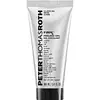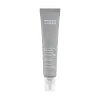What's inside
What's inside
 Key Ingredients
Key Ingredients

 Benefits
Benefits

 Concerns
Concerns

 Ingredients Side-by-side
Ingredients Side-by-side

Water
Skin ConditioningPEG-32
HumectantCellulose
AbsorbentButylene Glycol
HumectantCitrus Aurantium Bergamia Fruit Water
Skin ConditioningSorbitol
HumectantR-Bacillus Licheniformis Keratinase
Skin ConditioningAnanas Sativus Fruit Extract
Skin ConditioningLactobacillus/Punica Granatum Fruit Ferment Extract
Skin ConditioningLeuconostoc/Radish Root Ferment Filtrate
AntimicrobialSodium Hyaluronate
HumectantGlycerin
HumectantSodium Hydroxide
BufferingCitric Acid
BufferingTetrasodium EDTA
Algin
MaskingCarbomer
Emulsion StabilisingTromethamine
BufferingIsopropyl Myristate
EmollientSodium Chloride
MaskingCalcium Chloride
AstringentPotassium Sorbate
PreservativeSodium Benzoate
MaskingMica
Cosmetic ColorantPhenoxyethanol
PreservativeWater, PEG-32, Cellulose, Butylene Glycol, Citrus Aurantium Bergamia Fruit Water, Sorbitol, R-Bacillus Licheniformis Keratinase, Ananas Sativus Fruit Extract, Lactobacillus/Punica Granatum Fruit Ferment Extract, Leuconostoc/Radish Root Ferment Filtrate, Sodium Hyaluronate, Glycerin, Sodium Hydroxide, Citric Acid, Tetrasodium EDTA, Algin, Carbomer, Tromethamine, Isopropyl Myristate, Sodium Chloride, Calcium Chloride, Potassium Sorbate, Sodium Benzoate, Mica, Phenoxyethanol
Water
Skin ConditioningAminomethyl Propanol
BufferingGlycolic Acid
BufferingLactic Acid
BufferingMandelic Acid
AntimicrobialIsoamyl Laurate
EmollientTartaric Acid
BufferingPropanediol
SolventSalicylic Acid
MaskingMalic Acid
BufferingButylene Glycol
HumectantClitoria Ternatea Flower Extract
Skin ConditioningSodium Hyaluronate
HumectantGlycyrrhetinic Acid
Skin ConditioningGlycerin
HumectantTocopherol
AntioxidantBisabolol
MaskingAllantoin
Skin ConditioningHydroxyethylcellulose
Emulsion StabilisingHydrogenated Lecithin
EmulsifyingXanthan Gum
EmulsifyingPolyglyceryl-4 Laurate
EmulsifyingPolyacrylate Crosspolymer-6
Emulsion StabilisingTitanium Dioxide
Cosmetic ColorantMica
Cosmetic ColorantPhenoxyethanol
PreservativeWater, Aminomethyl Propanol, Glycolic Acid, Lactic Acid, Mandelic Acid, Isoamyl Laurate, Tartaric Acid, Propanediol, Salicylic Acid, Malic Acid, Butylene Glycol, Clitoria Ternatea Flower Extract, Sodium Hyaluronate, Glycyrrhetinic Acid, Glycerin, Tocopherol, Bisabolol, Allantoin, Hydroxyethylcellulose, Hydrogenated Lecithin, Xanthan Gum, Polyglyceryl-4 Laurate, Polyacrylate Crosspolymer-6, Titanium Dioxide, Mica, Phenoxyethanol
 Reviews
Reviews

Ingredients Explained
These ingredients are found in both products.
Ingredients higher up in an ingredient list are typically present in a larger amount.
Butylene Glycol (or BG) is used within cosmetic products for a few different reasons:
Overall, Butylene Glycol is a safe and well-rounded ingredient that works well with other ingredients.
Though this ingredient works well with most skin types, some people with sensitive skin may experience a reaction such as allergic rashes, closed comedones, or itchiness.
Learn more about Butylene GlycolGlycerin is already naturally found in your skin. It helps moisturize and protect your skin.
A study from 2016 found glycerin to be more effective as a humectant than AHAs and hyaluronic acid.
As a humectant, it helps the skin stay hydrated by pulling moisture to your skin. The low molecular weight of glycerin allows it to pull moisture into the deeper layers of your skin.
Hydrated skin improves your skin barrier; Your skin barrier helps protect against irritants and bacteria.
Glycerin has also been found to have antimicrobial and antiviral properties. Due to these properties, glycerin is often used in wound and burn treatments.
In cosmetics, glycerin is usually derived from plants such as soybean or palm. However, it can also be sourced from animals, such as tallow or animal fat.
This ingredient is organic, colorless, odorless, and non-toxic.
Glycerin is the name for this ingredient in American English. British English uses Glycerol/Glycerine.
Learn more about GlycerinMica is a naturally occurring mineral used to add shimmer and color in cosmetics. It can also help improve the texture of a product or give it an opaque, white/silver color.
Serecite is the name for very fine but ragged grains of mica.
This ingredient is often coated with metal oxides like titanium dioxide. Trace amounts of heavy metals may be found in mica, but these metals are not harmful in our personal products.
Mica has been used since prehistoric times throughout the world. Ancient Egyptian, Indian, Greek, Roman, Aztec, and Chinese civilizations have used mica.
Learn more about MicaPhenoxyethanol is a preservative that has germicide, antimicrobial, and aromatic properties. Studies show that phenoxyethanol can prevent microbial growth. By itself, it has a scent that is similar to that of a rose.
It's often used in formulations along with Caprylyl Glycol to preserve the shelf life of products.
Sodium Hyaluronate is hyaluronic acid's salt form. It is commonly derived from the sodium salt of hyaluronic acid.
Like hyaluronic acid, it is great at holding water and acts as a humectant. This makes it a great skin hydrating ingredient.
Sodium Hyaluronate is naturally occurring in our bodies and is mostly found in eye fluid and joints.
These are some other common types of Hyaluronic Acid:
Learn more about Sodium HyaluronateWater. It's the most common cosmetic ingredient of all. You'll usually see it at the top of ingredient lists, meaning that it makes up the largest part of the product.
So why is it so popular? Water most often acts as a solvent - this means that it helps dissolve other ingredients into the formulation.
You'll also recognize water as that liquid we all need to stay alive. If you see this, drink a glass of water. Stay hydrated!
Learn more about Water